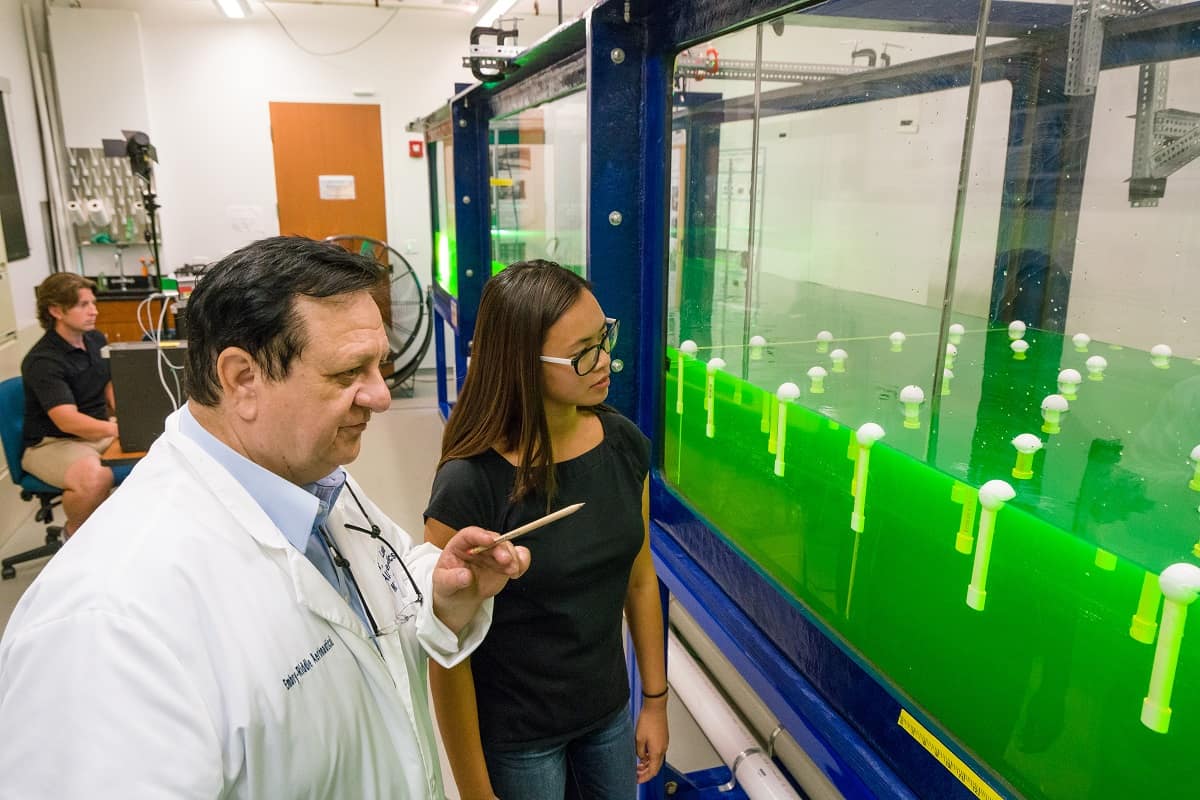Calming the Waters: Climate Change Impacts Take Shape in Wave Lab

A fully functional 32’ x 4’ x 4’ wave tank – equipped with high-speed cameras, multiple wave-makers and control systems capable of moving water at a rate of three feet per second – allows researchers to study the local influence of climate change. Rising seas affect the shape and behavior of shore waves and rip currents, explains Mathematics Professor Andrei Ludu.
Q: How do you study local climate-change impacts?
Near Embry-Riddle’s Daytona Beach, Fla., campus, Indian River Lagoon is one of the most diverse lagoon systems in the Northern hemisphere. The changing climate causes higher tides. It can also contribute to extreme weather events such as big storms. We want to understand the effect of different types of waves and storm surges on the lagoon as well as our local beaches, at different tide levels.
In the wave tank, we simulate various types of sea-floor topography, and we use a unique numerical model to predict outcomes. We can control the intensity and frequency of waves, to see if our predictions were correct. We can also apply wind and see what happens.
Q: How might this research help keep people safer?
As an example, if you precisely understand rip currents at different tide levels, you can add sand to the sea floor, to change the flow dynamics. You have to know exactly where to put the underwater dune, and how high and wide it should be.
Q: How does Wave Lab research relate to tornadoes?
Right now, we’re studying how to inhibit water waves by leveraging a phenomenon called Landau damping. In the future, we want to study the same mechanism in the air, to see if it might be useful for damping the destructive energy of tornadoes, too.
Q: What is energy resonance?
We know, based on work by the late physicist Lev Landau, that an instability such as a big wave can be reduced or damped through an energy exchange between the waves and surface particles. If the particles are moving with, or faster than the wave, they get pushed along like surfers. If the particles are moving opposite to the wave, they’re stopped and they lose energy. That oscillation damps resonance, reducing the wave’s action.
In a plasma, electromagnetic energy can promote this resonance-damping effect. Charged particles moving in the same direction as a wave are accelerated by it. Those moving in the opposite direction slow down, dissipating energy. While I was working with students to demonstrate this effect on a large scale, we realized it could be used to damp rogue waves or tsunamis.
Q: How do you visualize this phenomenon?
We string six-inch pieces of PVC pipe between ping-pong balls and very strong magnets. The magnets sink in water, but the ping-pong balls stay vertical. When we generate a wave, the magnets repel each other, pretty much like free electrons in a plasma. At first, all of the magnets are pushed in one direction, but soon, some are moving in the opposite direction and energy resonance occurs. We essentially steal energy from the wave so that we are damping its action.
(Editor’s Note: This work was presented in May 2017 at the 4th International Conference on recent Advances in Pure and Applied Mathematics.)
We hope to try this in air, too. That’s where tornadoes come into it. Researchers have thrown different types of things into the air to try and damp the energy of tornadoes. To my knowledge, no one has tried to harness energy resonance for that purpose.
Q: What other projects take place in the Wave Lab?
Our many different projects include studying `macro algae’ drifts. In addition to microscopic algae, there are large algae structures like bushes that kill sea grass, which is an important nutrient for many species. These macro algae structures drift long distances. We’re studying this in collaboration with the Indian River Lagoon Council – part of the National Estuary Program.
Editor’s Note: This article was originally published in the spring 2018 edition of ResearchER magazine (Vol. 2, No. 1). The ResearchER archives can be found on Scholarly Commons.

 Ginger Pinholster
Ginger Pinholster